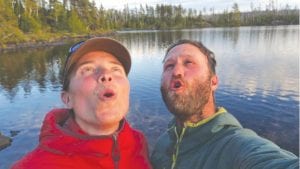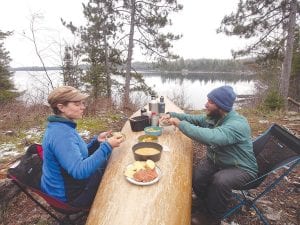Dave and Amy Freeman aren’t your usual married couple. In six years of marriage they have spent more time in a tent and in a canoe than they have in a vehicle or a house. They have covered more than 33,000 miles by paddling, portaging, dogsledding, or sailing and most recently spent an entire year in the Boundary Waters Canoe Area Wilderness (BWCAW), covering more than 3,000 miles as they explored the park.
As outdoor educators who use their adventures to teach children online about the wonders of the out-of-doors, this trip was a natural. But it was more than that, because the Freemans were there first and foremost to bring attention to the proposed nonferrous metals mining on the edge of the BWCAW, and its potential effects on the region’s watershed.
The Freemans are among a large group of people who are against the proposed mining by Twin Metals, with Minnesota Governor Mark Dayton leading the way. On March 7, 2016, Dayton said he would not grant access to state land that Twin Metals needs to develop its copper-nickel mine. In a letter to Twin Metals, Dayton said he had an obligation, as governor, to protect “an extraordinary natural legacy.”

During their time in the Boundary Waters Wilderness, the Freemans saw many signs of wolves, such as tracks and a wolf kill, but they didn’t see many of the animals. On September 20, when they heard wolves howling nearby, they joined in.
For Amy and Dave, who partnered with Save the Boundary Waters, a group headquartered in Ely, this trip was a chance to showcase the beauty of the BWCAW and to rally support against the mining. It was also a chance to see how they would fare living away from civilization for one year, although they did have more than 300 visitors who supplied them with food and company during their 12 months in the bush.
Still, there were difficult days, days where they pushed themselves to the max, but neither of them ever got sick and there was no thought to giving up.
“I think the last year has been the healthiest either of us have ever been,” said Dave. When asked how it felt to be back to their home in Cook County, the couple responded, “More than anything, a year in the wilderness has heightened our senses, caused us to slow down, live in the moment, and see how precious the Wilderness oases that remain on earth are to humanity and all life. It has become painfully clear that in an age when humans are more disconnected from nature than ever, the future of our species and the ecosystems that support us will be lost if Wilderness is lost.
“Wilderness is the earth’s DNA unaltered, a window into the complex framework of air, water, climate, soil, and nutrients that sustain all life; it is nature at its finest. Wilderness nourishes our souls and is the North Star guiding us towards a sustainable future. We must not lose sight of its value and we must speak loudly for these quiet places.”
While most days were filled with mundane tasks like getting firewood, preparing food, making a new campsite (they moved every three days or so) and planning the day’s movements, some days were fraught with danger. Among those, said Dave, were the ones when the seasons were changing or were filled with big storms.
“Traveling over the thin ice as the lakes were freezing and again as the lakes were thawing was tricky. We wore dry suits to help protect us from the frigid water, carried ropes, ice picks and other safety items, but we were pushing ourselves and learning new skills during the shoulder seasons.
“There were several really strong storms this summer. The storm that killed two people on Basswood Lake in late July was really scary. We were camped on Birch Lake just east of Basswood and we had about half a dozen trees come down in our campsite. Our canoe was pinned, but not crushed under a fallen tree, and we huddled in the wind and rain for about 15 minutes watching for falling trees or branches because we were concerned a tree could come down on our tent.”
When asked how many lakes the couple visited, Amy replied, “We visited just over 500 lakes, rivers, and streams. Most of those were on regular travel routes. I would guess that we visited about 50 bodies of water that would be considered out of the way. Some had portage trails leading to them, but they were unmaintained, others had no trails and we just had to crash through the woods, or wade through marshes to get to them.”
Coming home was exciting but a little bit different then they expected, said Dave and Amy.
“It’s interesting that the hardest part about leaving the wilderness hasn’t been the over stimulation that comes from all the lights, cars, crowds. We are having a hard time being closed off from the outside world. We don’t see the sunrise and sunset, feel the temperature change through the day, or hear the wind. Walls form a barrier for our bodies and our senses. We find ourselves missing the deep connection with nature that Wilderness provides. We miss watching the light change as day turns into night like it did on Isabella Lake when I took a photo almost exactly a year ago.
“I am sure we will continue to miss the Wilderness and look forward to getting out into the Boundary Waters again soon, but we are looking forward to sharing our story and the importance of protecting places like the Boundary Waters in new ways.
“We are working on a book with Milkweed Editions, which will be published in the fall of 2017. Plus, we are working on a film and will be doing a lot of speaking over the coming months. As an example we are looking forward to presenting and teaching several classes at the Winterer’s Gathering and Arctic Film Festival at North House Folk School in November,” said Amy.
As far as the outdoor classroom, Amy added, “We enjoyed working with elementary and middle school classrooms through regular blog posts and other content that we shared on WildernessClassroom.com. We also had a bunch of families as well as several groups of high school age students visit us in the Wilderness. The students were really excited to learn about the wolves, moose, and other animals that we encountered.”
Dave and Amy will spend some time catching up with family and friends before embarking on a speaking tour and visiting with government officials, telling them their story and encouraging them to help stop any mining that may take place on the edge of the BWCAW.
“As more people learn about sulfide ore mining more people are concerned about allowing this type of mining in such a fragile place. New polling shows that 67 percent of Minnesota voters oppose sulfide-ore mining near the Boundary Waters; only 16 percent support it,” said Amy.
“We have made a lot of progress, but there is still a lot of work to do to help ensure the Boundary Waters watershed will be protected from sulfide ore mining pollution. We will continue to encourage people to visit www.SavetheBoundaryWaters.org where they can sign the petition and learn more,” Dave said.



Loading Comments